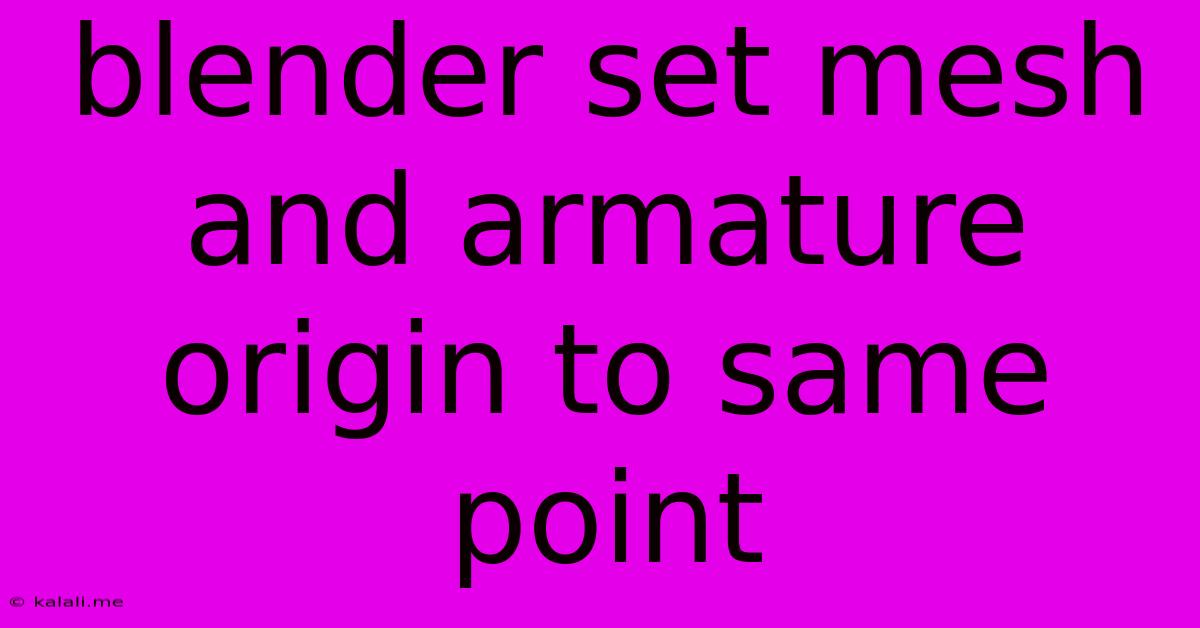Blender Set Mesh And Armature Origin To Same Point
Kalali
May 23, 2025 · 3 min read

Table of Contents
Blender: Aligning Mesh and Armature Origins for Seamless Rigging
Getting your mesh and armature origins to the same point in Blender is crucial for smooth animation and rigging. Misaligned origins can lead to unexpected rotations and translations, making your animation workflow frustrating and inefficient. This article will guide you through several methods to achieve perfect alignment, ensuring your rig behaves predictably and consistently. We'll cover techniques suitable for beginners and intermediate users alike.
Why Align Origins?
Before diving into the methods, let's understand why aligning origins is essential. When animating, the armature's origin acts as the pivot point for all bone transformations. If this pivot point doesn't match the mesh's center, the mesh will rotate around an unexpected point, causing undesirable distortions and making precise animation difficult. Aligning the origins ensures that your model moves and rotates naturally, simplifying the animation process significantly.
Methods for Aligning Origins
Here are several effective methods for aligning your mesh and armature origins:
Method 1: Using the "Set Origin" Menu (Recommended for Simple Models)
This method is the simplest and most intuitive, especially for models with a clearly defined center.
- Select your mesh: In the 3D viewport, select the mesh object you want to rig.
- Set Origin to Geometry: Go to the Object menu, then select "Set Origin," and choose "Origin to Geometry." This sets the origin to the geometric center of your mesh.
- Select your armature: Select the armature object.
- Set Origin to 3D Cursor: Go to the Object menu, then select "Set Origin," and choose "Origin to 3D Cursor." Ensure the 3D cursor is positioned at the desired center point before proceeding.
- Move 3D Cursor (Optional): If the geometry center isn't ideal, you can precisely position the 3D cursor by using the keyboard and mouse to fine-tune its location in the 3D viewport before setting the armature's origin.
This method is ideal for simple, symmetrical models where the geometric center is appropriate.
Method 2: Using the "Origin to Geometry" and "Origin to Selected" (For Precise Control)
This offers more precise control over origin placement.
- Select your mesh: Select your mesh object.
- Set Origin to Geometry: Set the origin to the geometry as described in Method 1.
- Select your Armature: Select the armature.
- Select Vertices (Optional): If the geometric center isn't suitable, select the vertices that represent the desired origin point on your mesh.
- Set Origin to Selected: Go to the Object menu, then select "Set Origin," and choose "Origin to Selected." This will set the armature's origin to the selected vertices. This allows for finer control than simply using "Origin to Geometry".
This is perfect for complex or asymmetrical models where a different center point is required.
Method 3: Parent First, Then Set Origin (For Complex Models)
This method ensures the armature's origin reflects the parent's origin.
- Parent the Mesh to Armature: With the mesh selected, Shift-select the armature and press Ctrl+P to parent the mesh to the armature. Choose "With Empty Groups" to have better control over bone assignments.
- Select the Armature: Select the armature object.
- Set Origin to Geometry: Set the armature's origin to its geometry using the "Set Origin" menu as previously explained. Since the mesh is already parented, this will effectively align both origins.
This is particularly useful for complex rigs where the armature's structure significantly influences the overall model's positioning.
Troubleshooting Tips
- Incorrect Transformations: Double-check your object's transformations (location, rotation, scale) in the Properties panel to ensure there are no unintended offsets.
- Multiple Objects: If you are working with multiple meshes, make sure you are aligning the origins of the correct objects.
- Complex Models: For complex models, consider using more advanced techniques or rigging methods.
By mastering these techniques, you'll significantly improve your rigging workflow in Blender, resulting in cleaner animations and a more efficient creative process. Remember to choose the method best suited to your model's complexity and your specific requirements.
Latest Posts
Latest Posts
-
Mount Air Conditioner At Slight Angle
May 23, 2025
-
Digital Control S Domain And Z Domain
May 23, 2025
-
Select All Is Selecting Transpaent Pixels Gimp
May 23, 2025
-
Do You Know The Muffin Man Shrek
May 23, 2025
-
Faucet Dripping After Water Turned Off
May 23, 2025
Related Post
Thank you for visiting our website which covers about Blender Set Mesh And Armature Origin To Same Point . We hope the information provided has been useful to you. Feel free to contact us if you have any questions or need further assistance. See you next time and don't miss to bookmark.